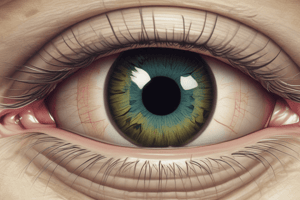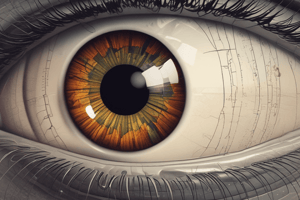Podcast
Questions and Answers
What is the primary function of the cover-uncover test?
What is the primary function of the cover-uncover test?
- To evaluate binocular vision
- To identify phorias
- To assess tropias (correct)
- To measure visual acuity
What does heterophoria indicate when comparing associated and dissociated eye positions?
What does heterophoria indicate when comparing associated and dissociated eye positions?
- Neither eye moves during fixation
- There is a constant deviation of one eye
- The passive eye position differs from the active eye position (correct)
- Both eyes are aligned
During the alternating cover test, what is primarily assessed?
During the alternating cover test, what is primarily assessed?
- The presence of tropia
- The optic nerve health
- The ability of eye muscles to work together
- The presence of phoria (correct)
Which of the following best describes the conditions under which the cover test should be performed?
Which of the following best describes the conditions under which the cover test should be performed?
What effect does covering one eye have during the cover test?
What effect does covering one eye have during the cover test?
When selecting a fixation target for the cover test, what is recommended if the visual acuity of the worst eye is less than 6/18?
When selecting a fixation target for the cover test, what is recommended if the visual acuity of the worst eye is less than 6/18?
What is the expected response of the right eye when the left eye is covered and no tropia is present?
What is the expected response of the right eye when the left eye is covered and no tropia is present?
What characteristic should be considered when choosing a fixation target for children during the cover test?
What characteristic should be considered when choosing a fixation target for children during the cover test?
What movement indicates the presence of a tropia during the cover test of the left eye?
What movement indicates the presence of a tropia during the cover test of the left eye?
Which statement best describes right exotropia?
Which statement best describes right exotropia?
How can one confirm the presence of a phoria?
How can one confirm the presence of a phoria?
What does left esotropia imply about the left eye when it is fixating?
What does left esotropia imply about the left eye when it is fixating?
What would the response of the left eye indicate during the cover test if left hypertropia is present?
What would the response of the left eye indicate during the cover test if left hypertropia is present?
What defines orthophoria during a cover test?
What defines orthophoria during a cover test?
Which of the following is true about left hypotropia?
Which of the following is true about left hypotropia?
What is indicated when the right eye moves out during the alternating cover test?
What is indicated when the right eye moves out during the alternating cover test?
If the left eye has to move upwards upon removing the cover from the right eye, what does this indicate?
If the left eye has to move upwards upon removing the cover from the right eye, what does this indicate?
Which condition results in the eyes being vertically misaligned in the passive position?
Which condition results in the eyes being vertically misaligned in the passive position?
In the context of the cover test, what characterizes left tropia?
In the context of the cover test, what characterizes left tropia?
When performing a distance cover test, how should the examination be conducted?
When performing a distance cover test, how should the examination be conducted?
What does alternating cover test primarily help in determining?
What does alternating cover test primarily help in determining?
What is the primary purpose of using a fixation target during the eye examination?
What is the primary purpose of using a fixation target during the eye examination?
When conducting the near cover test, which situation is NOT appropriate?
When conducting the near cover test, which situation is NOT appropriate?
In Herrings law, what action occurs when an impulse is received by one eye's muscles?
In Herrings law, what action occurs when an impulse is received by one eye's muscles?
What is typically the first observation when recording a phoria?
What is typically the first observation when recording a phoria?
What does the movement of the cover test during 'Phi' movements indicate when the target moves in the opposite direction of the occluder?
What does the movement of the cover test during 'Phi' movements indicate when the target moves in the opposite direction of the occluder?
Which test is considered to be the least accurate for detecting strabismus in very young children?
Which test is considered to be the least accurate for detecting strabismus in very young children?
What is the significance of a brighter red reflex in the deviating eye during the Brückner test?
What is the significance of a brighter red reflex in the deviating eye during the Brückner test?
In the Krimsky's test, what additional component is used to measure eye deviation?
In the Krimsky's test, what additional component is used to measure eye deviation?
What common characteristic can lead to a misdiagnosis of strabismus in children?
What common characteristic can lead to a misdiagnosis of strabismus in children?
How is the magnitude of a phoria typically recorded?
How is the magnitude of a phoria typically recorded?
What is the purpose of using the Hirschberg test during an eye examination?
What is the purpose of using the Hirschberg test during an eye examination?
During the cover/uncover test, which factor should not be mistaken for tropia due to Herrings law?
During the cover/uncover test, which factor should not be mistaken for tropia due to Herrings law?
Which of the following is NOT a recommended fixation target for children during assessments?
Which of the following is NOT a recommended fixation target for children during assessments?
What key aspect is crucial for evaluating binocular vision with current spectacles?
What key aspect is crucial for evaluating binocular vision with current spectacles?
Flashcards
Heterophoria
Heterophoria
Dissociated eye position differs from active eye position. It describes the eye's position when not actively fixating on a target.
Associated eye position
Associated eye position
The position of both eyes when actively fixating on a target, working together.
Dissociated eye position
Dissociated eye position
The position of one eye when the other is covered and prevented from actively fixating. It represents the eye's natural tendency without the influence of the other eye.
Cover test
Cover test
Signup and view all the flashcards
Cover-uncover test
Cover-uncover test
Signup and view all the flashcards
Alternating cover test
Alternating cover test
Signup and view all the flashcards
Cover/uncover test
Cover/uncover test
Signup and view all the flashcards
Fixation target
Fixation target
Signup and view all the flashcards
Tropia
Tropia
Signup and view all the flashcards
Exotropia
Exotropia
Signup and view all the flashcards
Esotropia
Esotropia
Signup and view all the flashcards
Hypertropia
Hypertropia
Signup and view all the flashcards
Hypotropia
Hypotropia
Signup and view all the flashcards
Alternating tropia
Alternating tropia
Signup and view all the flashcards
Phoria
Phoria
Signup and view all the flashcards
Orthophoria
Orthophoria
Signup and view all the flashcards
Exophoria
Exophoria
Signup and view all the flashcards
Esophoria
Esophoria
Signup and view all the flashcards
Hyperphoria
Hyperphoria
Signup and view all the flashcards
R/L hyperphoria
R/L hyperphoria
Signup and view all the flashcards
L/R hyperphoria
L/R hyperphoria
Signup and view all the flashcards
Distance cover test
Distance cover test
Signup and view all the flashcards
Binocular Vision
Binocular Vision
Signup and view all the flashcards
Conjugate Eye Movements
Conjugate Eye Movements
Signup and view all the flashcards
Fixating Eye
Fixating Eye
Signup and view all the flashcards
Deviating Eye
Deviating Eye
Signup and view all the flashcards
Strabismus
Strabismus
Signup and view all the flashcards
Pseudostrabismus
Pseudostrabismus
Signup and view all the flashcards
Herrings Law
Herrings Law
Signup and view all the flashcards
Hirschberg Test
Hirschberg Test
Signup and view all the flashcards
Study Notes
Binocular Vision Lecture 4
- Objective measurement of eye deviations is the focus
- Students will be able to perform and interpret cover tests
- Including the Brückner test, Hirschberg method, and Krimsky test
Introduction
- Heterophoria: Dissociated (passive) eye position differs from associated (active) position
- Associated position: When both eyes are fixated on a target
- Dissociated position: When one eye is covered
- Sensory fusion is prevented, and fusional vergence doesn't occur when one eye is covered
- Covering an eye allows assessment of heterophoria as the eye moves from associated to dissociated position
The Cover Test - When used
- Used in every sight test
- Objective method to assess heterophoria and heterotropia
- Differentiates between phoria and tropia
Cover-uncover and Alternating Cover
- Two parts to the cover test
- Part 1 (cover-uncover): Identifies tropias
- Part 2 (alternating cover): Identifies phorias
Set up – Distance Cover Test
- Room lights on for proper visibility
- Explain the test's purpose; eye muscle function
- Test should be performed with and without spectacles
- Determine fixation target (e.g., letter on line above worst eye's vision, or spotlight if < 6/18 vision)
- Patient should fixate throughout the test
- Patient's gaze should be in their primary position
Conducting the Procedure - Cover/Uncover Test
- Determining right eye tropia: Cover left eye; observe response of right eye; hold cover 3 seconds. If right eye doesn't move = no tropia; if moves = tropia.
- Determining left eye tropia: Cover right eye; observe response of left eye; hold cover 3 seconds. If left eye doesn't move = no tropia; if moves = tropia.
Investigation of a Heterotropia
- One eye fixates; other deviates
- Large deviations are visible without a cover test
Classifying Your Findings
- One eye fixates; other eye deviates
- Large deviations are visible even without a cover test (examples of left exotropia shown)
What to Expect When No Tropia Is Present
- When cover test moves over left eye, right eye does not move
- When cover test moves over right eye, left eye does not move
Right Exotropia
- Right eye abducts when left eye fixates
- Right eye moves inwards when cover test moves over left eye
- Right eye doesn't move when cover test moves over right eye
Left Esotropia
- Left eye adducts when right eye fixates
- Left eye abducts to take up fixation when the cover test covers the right eye
Left Hypertropia
- Left eye is superior to the right eye when fixated
- Left eye moves down to take up fixation when the cover moves over the right eye
Left Hypotropia
- Left eye is inferior to the right eye when fixated
- Left eye moves up to take up fixation when the cover moves over the right eye
Alternating Tropia
- Either eye can fixate; generally one will be preferred
- When cover is over the left eye, the right eye moves to take up fixation
- Right eye maintains position until the right eye is covered
Investigation of a Heterophoria
- Active position of the eye doesn't match the passive position
If no tropia, then determine if a phoria is present.
- Phoria is when eye's active position differs from its passive position
- Uncovered eye is in its active position
- Covered eye moves to a passive position (this is phoria)
Orthophoria - What Happens Under the Cover
- Passive and active eye positions match
- The eye under the cover will not move
Exophoria - What Happens Under the Cover
- Eyes are more divergent in passive position
- Covered eye moves outward
Esophoria - What Happens Under the Cover
- Eyes are more convergent in passive position
- Covered eye moves inward
R/L Hyperphoria - What Happens Under the Cover
- Eyes are vertically misaligned in passive position
- Right eye moves up (or down) if its covered
- Left eye moves down (or up) if its covered
L/R Hyperphoria - What Happens Under the Cover
- Eyes are vertically misaligned in passive position.
- Right eye moves down if its covered
- Left eye moves up if its covered
So How Do We Investigate a Phoria?
- Occluders are opaque; frosted occluders help with this
- Methods include looking behind the occluder during the cover/uncover test; asking patient about target movement; performing an alternating cover test (best method)
Alternating Cover Test
- Same set up as the cover/uncover test
- Patient determines presence of phoria by watching eye movements (3 second intervals) with swapping of eyes
Orthophoria - What is Seen on Alternating Cover Test
- Eye under the cover does not move
Exophoria - What is Seen on Alternating Cover Test
- Covered eye moves to its divergent passive position
- Eye returns into position once cover is removed
Esophoria - What is Seen on Alternating Cover Test
- Covered eye moves to its convergent passive position
- Eye returns into position once cover is removed
R/L Hyperphoria – What is Seen on Alternating Cover Test
- Right eye moves down (or up), left eye moves up or down to retake fixation
L/R Hyperphoria – What is Seen on Alternating Cover Test
- Right eye moves up (or down), left eye moves up or down to retake fixation
Distance Cover Test
- Conducted without and with corrective lenses
- To examine binocular vision in absence of corrective lenses/specs
- Patient may be wearing prism without knowing it
- Determining effect of refraction on binocular vision system
Set up – Near Cover Test
- Similar set up to the distance cover test
- Patient looks at a near target
- Fixation target can be chosen; letter on line above worst visual acuity using a "budgie stick"; spotlight
Near Cover Test
- Conducted without and with corrective lenses
- To examine binocular vision in absence of corrective lenses/specs
- Patient may be wearing prism without knowing it
- Determining effect of refraction on binocular vision system
Things to Watch Out For - Herrings Law
- Herrings law: When an impulse to move one eye is sent, the other eye reacts in the same direction.
- Large phorias may make the eye appear to have a tropia.
- This information will help determine if there was a true tropia or a false one.
Things to Watch Out For - Pseudostrabismus
- Pseudostrabismus is often seen in children.
- The epicanthus (skin fold over the inner canthus) can make it look like strabismus; no strabismus is present.
Other Objective Tests
- Brückner test: Compares the red reflexes in both eyes
- Hirschberg test: Measures corneal reflexes to ascertain directionality of eye deviation(1mm = 20 degree)
- Krimsky test: Modified Hirschberg; adds prisms to measure deviation accurately.
Recording a Phoria
- Direction (eso, exo, R/L, L/R)
- Magnitude (Prism dioptres)
- Fixation distance (distance, near)
- Compensation (good, moderate, poor)
Recording a Tropia (the minimum)
- Which eye (and laterality)
- Direction (eso/exo/hyper/hypo)
- Magnitude (prism dioptres)
- Fixation distance (near/far)
Determining the Size of the Deviation
- Experienced practitioners estimate deviation size.
- Practices to estimate include using a ruler for patient and friend, asking the patient to describe the target to see any deviations; use of prism bars
Cover Test 'Phi' Movements
- Adds subjectivity to cover test.
- Targets move in opposite direction to determine phoria
- Can help to identify small phorias
Conclusion
- Important to understand and execute these tests correctly, and understand how to spot false positives when performing assessments
Studying That Suits You
Use AI to generate personalized quizzes and flashcards to suit your learning preferences.





